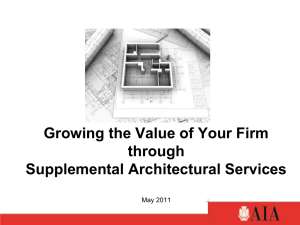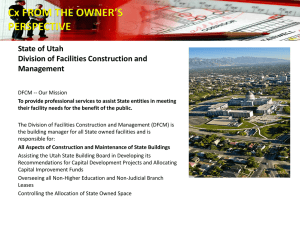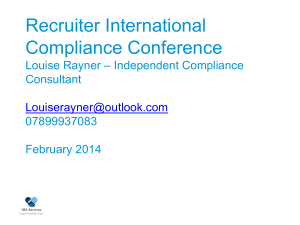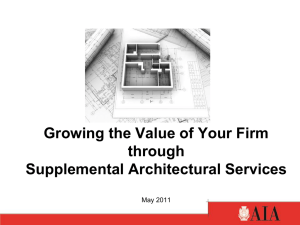Words Do Matter ACWA Fall 2013
advertisement
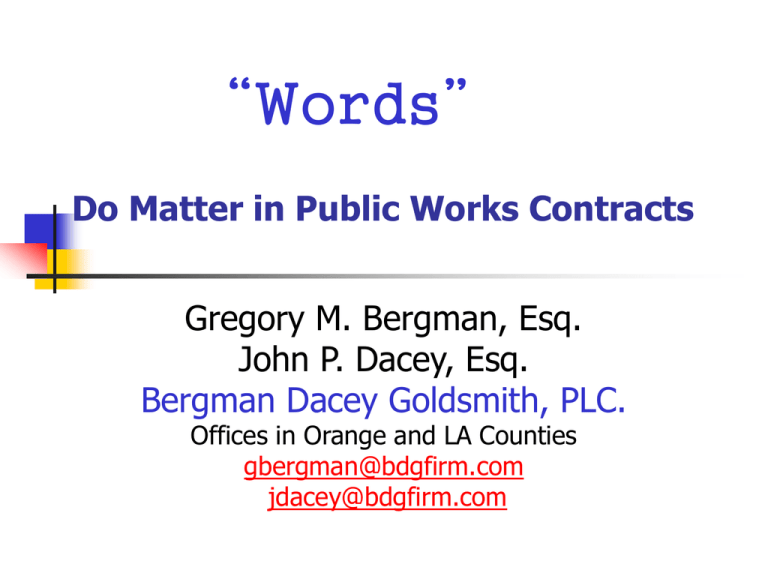
“Words” Do Matter in Public Works Contracts Gregory M. Bergman, Esq. John P. Dacey, Esq. Bergman Dacey Goldsmith, PLC. Offices in Orange and LA Counties gbergman@bdgfirm.com jdacey@bdgfirm.com Key Principles Two key principles for the public entity owner engaged in construction: Cash - the “Lifeblood of Construction”; and Specific Standards & Deliverables = the “Owner’s Safety Net”. Build your contracts, policies, and procedures around these two key principles to achieve success. Proper Context An owner enters many contracts to build a construction project (General Contractor, Architect, Engineers, Construction Manager, Geotechnical, Testing Lab(s), Inspectors, Payment and Performance Bonds, etc.). The General Contractor in turn uses a multitude of subcontractors to actually build the project, meaning many more contracts are involved. Think of all of these contracts as the arteries of the project through which the Lifeblood of Construction (“cash”) must flow. A project that pays well is usually a successful project. PROGRESSING THE WORK Contract relationships = arteries of a construction project Cash is the lifeblood that progresses the work Efficient cash flow = more work done Contractors and subs work on jobs that pay promptly The Owner’s Safety Net • Don’t get left “holding the bag”! Because of the number of people/companies an owner hires to build a project, an owner needs to ensure that risk and responsibility are clearly apportioned at the outset. Fail to do so and the owner is the ultimate loser. The Owner’s Safety Net * Specific Standards; & * Specific Deliverables = how to avoid the bag! Help the Cash Flow Progress Payments: Statutory Requirements; Processing; and Joint Check Option. do not just reject and return. Pay all supported portions of a progress payment request, rejecting only the unsupported portions; explain why. Help the Cash Flow Stop Payment Notice Release Bonds: Make Them a Contract Requirement. in the general contract, require the general contractor to furnish one within five days of every stop notice served on a public entity. Help the Cash Flow Back Charge Provisions; Third Party Contractors & Assignment Rights. have a good solid back charge provision in the general contract to provide the owner with cash and the contractual ability to get work done if the general contractor refuses or fails to promptly take care of the work. Use a third party contractor to handle these “stalemates”. Help the Cash Flow Joint Check Option. make sure its in the owner’s contract so the owner can ensure proper payment to subcontractors and suppliers, if the general is not doing so. Help the Cash Flow Partial Agreement Change Orders. use this process to ensure that the money flows to the subs who are building the project - subs should not have to “finance the job”. Help the Cash Flow Expedited Claims Process. adopt one so that all disputes are resolved within 90 days of the filing of a claim or rights are lost; eliminates the “cumulative impact” claim. Help the Cash Flow Substantial Completion; “True” Final Punch List; Statutory and contract definitions must match; Minor or trivial items only; defective work is not a punch list item; estimate the value of each punch list item; punch list work must be part of the close out process and scheduled. Help the Cash Flow Timely Release of Undisputed Retention. How do you determine amount? Specified time within which to act; Specified limit on amounts withheld; Explain reason and calculation of the withhold; 2% per month interest/penalty, attorneys’ fees; Notice of Completion fallacy – be aware! Help the Cash Flow Close Out & Retention. build and schedule a reasonable but firm Close Out Process into the general contract tied to the owner’s back charge, offset, joint check, third party contractor and other remedies and coordinate with the timely release of undisputed retention. Help the Cash Flow Escrow Account; The Performance Bond Surety. Use them always; For escrowed retention, draft the escrow agreement so that the owner can access the retention upon a “declaration of a default in writing”. Not “in the event of ….” Help the Cash Flow PCC 22300 (f)(7) states: “The Owner shall have a right to draw upon the securities in the event of a default by the Contractor. Upon seven days’ written notice to the Escrow Agent from the owner of the default, the Escrow Agent shall immediately convert the securities to cash and shall distribute the cash as instructed by the Owner.” Change section (f)(7) to read: “The Owner shall have a right to draw upon the securities if the Owner declares a default by the Contractor. Upon seven days’ written notice to the Escrow Agent from the owner of the default, the Escrow Agent shall immediately convert the securities to cash and shall distribute the cash as instructed by the Owner.” Help the Cash Flow How can you do so? Section 22300 (f) states the escrow agreement shall be null, void and unenforceable unless it is “substantially similar” to the following form….” Don’t just cut and paste – think! Help the Cash Flow The Performance Bond Surety. Draft your own; to use independently bonded obligations in the performance bond or not (what are they?). Help the Cash Flow Liquidated Damages vs. Consequential Damages for Delay; When to use each. How badly do you need the project finished on time? Help the Cash Flow Indemnity – Defense and Hold Harmless Provisions. In addition to property damage and personal injury, add “economic loss”. Don’t buy the argument that “I can’t insure this”, it’s a red herring! Help the Cash Flow Specific Performance Standards vs. Standard in the Industry. What is the “standard in the industry?” Why obligate someone to comply with something that is so elusive its like trying to capture a drop of mercury on a pane of glass? Use it and lose- get left holding the bag. Establish your performance standards by using express and explicit contract language. Help the Cash Flow Specific Deliverables vs. Standard in the Industry. Same concept - “standard in the industry” does not protect the owner—only the other party. Establish specific deliverables by using express and explicit contract language. Help the Cash Flow Establish Acceptable and NonAcceptable Percentages of Errors & Omissions. There are things you can do and one of them is to put very specific language in your professional service contracts to apportion risk over which the professional service provider has control; Agreed to percentage for errors and omissions eliminates disputes and establishes the path for dispute resolution. Sample Language 7.8 Errors and Omissions In addition to the standards and requirements set forth elsewhere in this Agreement, including but not limited to in Article 16 hereof, this Article 7.8 and Article 7.81 establishes standards and requirements that specifically govern the ARCHITECT’S and DISTRICT’S apportionment of the risks associated with errors and omissions in the Construction Documents and/or for other failure on the part of the ARCHITECT to perform services and work under this Agreement. Sample Language - cont’d 7.8.1 A. Responsibility for Errors and Omissions Errors: All of the monetary cost, amount, and/or level of damage caused, in whole or in part, by the errors of the ARCHITECT, the ARCHITECT’S Consultants and/or Sub-Consultants for the Project, shall be aggregated together using 100% of such cost, amount and/or level of damage (“Aggregate Total”). If the Aggregate Total is less than four percent (4%) of the Contractor’s Base Bid Price, then the DISTRICT shall pay for the cost and/or expense of correcting same by absorbing the price agreed to between the DISTRICT and the Contractor to correct such errors by way of change order. However, the ARCHITECT and ARCHITECT’S Consultants and Sub-Consultants shall provide and perform all services and work necessary to correct the Construction Documents without any charge, cost or expense to the DISTRICT for such services and/or work. However, if the Aggregate Total is equal to or greater than four percent (4%) of the Contractor’s Base Bid Price, then the ARCHITECT shall pay for one hundred percent (100%) of the cost and/or expense of correcting same by absorbing the price agreed to between the DISTRICT and the Contractor to correct such errors by way of change order. Additionally, the ARCHITECT and ARCHITECT’S Consultants and Sub-Consultants shall provide and perform all services and work necessary to correct the Construction Documents without any charge, cost or expense to the DISTRICT for such services and/or work. The obligations established by this Article 7.8.1 A. are in addition to, and cumulative of, the DISTRICT’S indemnity rights under this Agreement. Sample Language - cont’d B. Omissions: All of the monetary cost, amount, and/or level of damage caused, in whole or in part, by the omissions of the ARCHITECT, the ARCHITECT’S Consultants and/or SubConsultants for the Project shall be aggregated together using 100% of such cost, amount and/or level of damage (“Aggregate Total”). The Aggregate Total shall then be divided into two parts: the Sixty Percent (60%) part and the Forty Percent (40%) part. If the Forty Percent (40%) part, over the life of the Project, totals less than four percent (4%) of the Contractor’s Base Bid Price, then the DISTRICT shall bear responsibility for the cost of the Sixty Percent (60%) part and the ARCHITECT shall bear responsibility for the cost of the Forty Percent (40%) part. However, the ARCHITECT and ARCHITECT’S Consultants and Sub-Consultants shall provide and perform all services and work necessary to correct the Construction Documents without any charge, cost or expense to the DISTRICT for such services and/or work. However, if the Forty Percent (40%) part, over the life of the Project, equals or is greater than four percent (4%) of the Contractor’s Base Bid Price, then the ARCHITECT shall bear responsibility for the cost of one hundred percent (100%) of the cost, amount, and/or level of damage caused, in whole or in part, by such omissions. Additionally, the ARCHITECT and ARCHITECT’S Consultants and SubConsultants shall provide and perform all services and work necessary to correct the Construction Documents without any charge, cost or expense to the DISTRICT for such services and/or work. The obligations established by this Article 7.8.1 B. are in addition to, and cumulative of, the DISTRICT’S indemnity rights under this Agreement. Words Do Matter But people matter more …! “The greatest contract and process in the world is only as good as the people involved.” Make a difference! Thank You John and Greg Bergman Dacey Goldsmith, PLC. Offices in Orange and LA Counties gbergman@bdgfirm.com jdacey@bdgfirm.com




